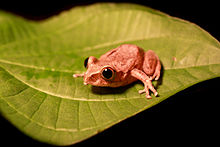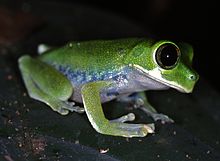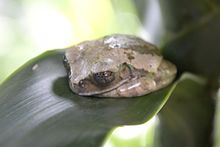Forest climber frogs
| Forest climber frogs | ||||||||||||
|---|---|---|---|---|---|---|---|---|---|---|---|---|

A forest climber frog |
||||||||||||
| Systematics | ||||||||||||
|
||||||||||||
| Scientific name of the subfamily | ||||||||||||
| Leptopelinae | ||||||||||||
| Laurent , 1972 | ||||||||||||
| Scientific name of the genus | ||||||||||||
| Leptopelis | ||||||||||||
| Günther , 1859 |
The forest climber frogs ( Leptopelis ) are a genus of African frogs in the family of long finger frogs (Arthroleptidae).
features
The most striking feature are the very large eyes with perpendicular pupils. The animals are about five to ten centimeters tall. The females are often significantly larger than the males. Some species have a different coloring in their youth than in the adult stage; the “youth dress” is then green. Mostly they are colored brown with a darker pattern on the back, the underside is light colored. Somewhat more colorful species are for example Leptopelis flavomaculatus and Leptopelis uluguruensis . The eye color goes from a dark brown-golden yellow to red (such as Leptopelis parkeri ). Differentiating the individual species is difficult because many species are very similar and are often only differentiated by their geographical occurrence. Some species were also determined on the basis of individual finds. The pupil is vertical and the eyes are typically large for nocturnal animals, which has earned them the name “African big-eyed tree frog”. This makes them easy to distinguish from other taxa .
distribution
Due to their common German name, the forest climber frogs could be confused with the tree climber frogs (Dendrobatidae). While these are to be found in South and Central America , the forest climber frogs occur exclusively in Africa south of the Sahara to eastern South Africa .
Way of life
It is typical for some of these frogs that they bury themselves in the moist soil during dry seasons and are then active again in the wetter seasons. Their eggs are laid in the moist soil or moss, from where the tadpoles then find their way to the water after hatching. Some mating calls are described as a short “click”; other types also call more melodious.
Systematics and taxonomy
After the introduction of new phylogenetic methods in research at the beginning of the 21st century, doubts arose about the relationship between the forest climber frogs and the other reed frogs (Hyperoliidae) to which they had been counted up to then. After a detailed molecular genetic study by Darrel R. Frost and other scientists called The Amphibian Tree of Life in 2006, they were therefore placed in the family of long-fingered frogs (Arthroleptidae). There Leptopelis forms the only genus of the subfamily Leptopelinae.
genus
The type species of the genus is the Gabon forest climber frog ( Leptopelis aubryi ) originally described under the name Hyla aubryi .
species
The genus includes 52 species:
As of May 20, 2020
- Leptopelis anchietae ( Bocage , 1873)
- Leptopelis anebos Portillo & Greenbaum , 2014
- Leptopelis argenteus ( pepper , 1893)
- Leptopelis aubryi ( Duméril , 1856) - Gabon forest climber frog
- Leptopelis aubryioides ( Andersson , 1907) ; Synonym : Leptopelis omissus Amiet , 1992
- Leptopelis bequaerti Loveridge , 1941
- Leptopelis bocagii ( Günther , 1865)
- Leptopelis boulengeri ( Werner , 1898)
- Leptopelis brevirostris ( Werner , 1898) - Cameroon forest climber frog
- Leptopelis broadleyi (Poynton , 1985)
- Leptopelis bufonides Schiøtz , 1967
- Leptopelis calcaratus ( Boulenger , 1906)
- Leptopelis christyi ( Boulenger , 1912)
- Leptopelis concolor Ahl , 1929
- Leptopelis cynnamomeus ( Bocage , 1893)
- Leptopelis fenestratus Laurent , 1972
- Leptopelis fiziensis Laurent , 1973
- Leptopelis flavomaculatus ( Günther , 1864) ; Synonym: Leptopelis barbouri Ahl , 1929 - Yellow-brown forest climber frog
- Leptopelis gramineus ( Boulenger , 1898)
- Leptopelis grandiceps Ahl , 1929 ; Synonym: Leptopelis usambarae Ahl , 1929
- Leptopelis jordani Parker , 1936
- Leptopelis karissimbensis Ahl , 1929
- Leptopelis kivuensis Ahl , 1929
- Leptopelis lebeaui ( De Witte , 1933)
- Leptopelis mackayi Koehler , Bwong , Schick , Veith & Lötters , 2006
- Leptopelis macrotis Schiøtz , 1967
- Leptopelis marginatus ( Bocage , 1895)
- Leptopelis millsoni ( Boulenger , 1895)
- Leptopelis modestus ( Werner , 1898)
- Leptopelis mossambicus Poynton , 1985
- Leptopelis mtoewaate Portillo & Greenbaum , 2014
- Leptopelis natalensis ( Smith , 1849)
- Leptopelis nordequatorialis Perret , 1966
- Leptopelis notatus ( Peters , 1875)
- Leptopelis occidentalis Schiøtz , 1967
- Leptopelis ocellatus ( Mocquard , 1902)
- Leptopelis oryi Inger , 1968
- Leptopelis palmatus ( Peters , 1868)
- Leptopelis parbocagii Poynton & Broadley , 1987
- Leptopelis parkeri Barbour & Loveridge , 1928 - Parker's forest climber frog
- Leptopelis parvus Schmidt & Inger , 1959
- Leptopelis ragazzii ( Boulenger , 1896)
- Leptopelis rufus Reichenow , 1874 - Red forest climber frog
- Leptopelis spiritusnoctis Rödel , 2007
- Leptopelis susanae Largen , 1977
- Leptopelis uluguruensis Barbour & Loveridge , 1928 - Spotted forest climber frog
- Leptopelis vannutellii ( Boulenger , 1898)
- Leptopelis vermiculatus ( Boulenger , 1909) - green forest climber frog
- Leptopelis viridis ( Günther , 1869)
- Leptopelis xenodactylus Poynton , 1963
- Leptopelis yaldeni Largen , 1977
- Leptopelis zebra Amiet , 2001
Leptopelis brevipes ( Boulenger , 1906) and Leptopelis crystallinoron Lötters , Rödel & Burger , 2005 are synonyms of Leptopelis brevirostris (Werner , 1898) (Cameroon forest climber frog ).
gallery
Leptopelis vermiculatus , male
Leptopelis vermiculatus , juvenile
Leptopelis vermiculatus , female
Individual evidence
- ↑ Miguel Vences, J. Kosuch, F. Glaw, W. Böhme, and M. Veith. Molecular phylogeny of hyperoliid treefrogs: biogeographic origin of Malagasy and Seychellean taxa and re-analysis of familial paraphyly. Journal of Zoological Systematics and Evolutionary Research, 41, pp. 205-213, 2003.
- ↑ Darrel R. Frost, Taran Grant, Julián Faivovich, Raoul H. Bain, Alexander Haas, Celio FB Haddad, Rafael O. de Sá, A. Channing, Mark Wilkinson, Stephen C. Donnellan, Christopher J. Raxworthy, Jonathan A. Campbell, Boris L. Blotto, Paul E. Moler, Robert C. Drewes, Ronald A. Nussbaum, John D. Lynch, David M. Green, and Ward C. Wheeler: The amphibian tree of life. Bulletin of the American Museum of Natural History, 297, pp. 1-370, 2006 full text
- ↑ a b Darrel R. Frost: Leptopelis , Amphibian Species of the World, Version 6.0, The American Museum of Natural History, 1998-2015, accessed August 28, 2015
- ↑ Frank Portillo & Eli Greenbaum: At the Edge of a Species Boundary: A New and Relatively Young Species of Leptopelis (Anura: Arthroleptidae) from the Itombwe Plateau, Democratic Republic of the Congo. Herpetologica, 70, 1, pp. 100-119, 2014
- ^ J. Koehler: The Identity of Hylambates rufus aubryioides Andersson, 1907 (Anura: Arthroleptidae) from Cameroon. Copeia, pp. 57-61, 2009
- ↑ a b Václav Gvoždík, Frank Tillak, Michele Menegon & Simon P. Loader: The status of Leptopelis barbouri Ahl, 1929 and eleven other nomina of the current tree-frog genus Leptopelis (Arthroleptidae) described from East Africa, with a redescription of Leptopelis grandiceps Ahl, 1929. Zootaxa, 3793, 1, pp. 165-187, 2014
literature
- Arne Schiøtz: Treefrogs of Africa . Edition Chimaira, Frankfurt / Main 1999 ISBN 3-930612-24-0
- Albert Carl Ludwig Gotthilf Günther : Catalog of the Batrachia Salientia in the Collection of the British Museum. Taylor and Francis, London 1859 (first description of the genre)
- RF Laurent: Review: "The morphology, systematics, and evolution of the Old World treefrogs (Rhacophoridae and Hyperoliidae)", by SS Liem (1970) . Copeia, pp. 198–201, 1972 (first description of the subfamily)
Web links
- Darrel R. Frost: Leptopelis , Amphibian Species of the World, Version 6.0, The American Museum of Natural History, 1998-2015
- Arthroleptidae List of species of the Arthroleptidae family at Amphibiaweb
- Leptopelis in the IUCN 2018Red List of Threatened Species.















